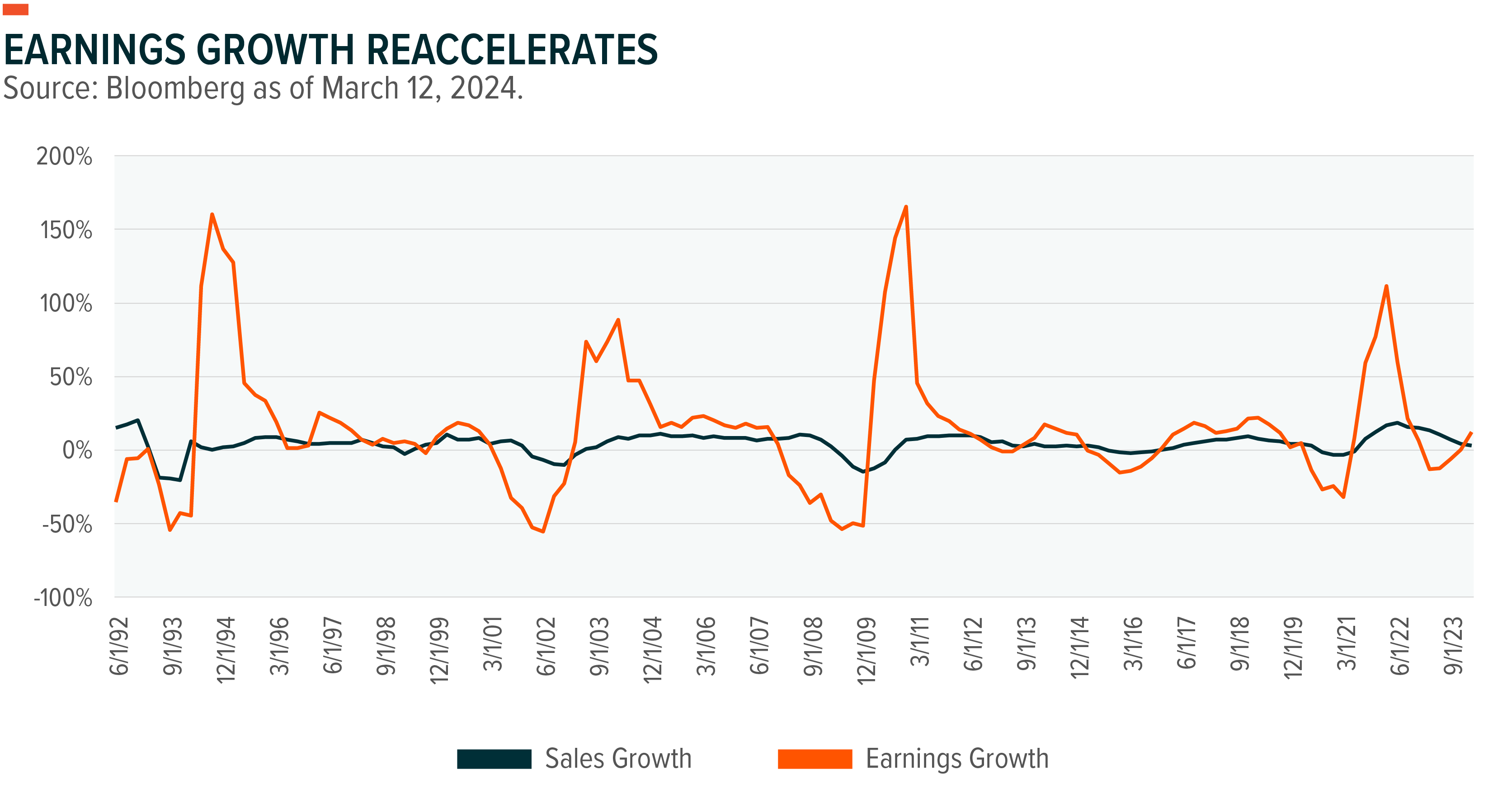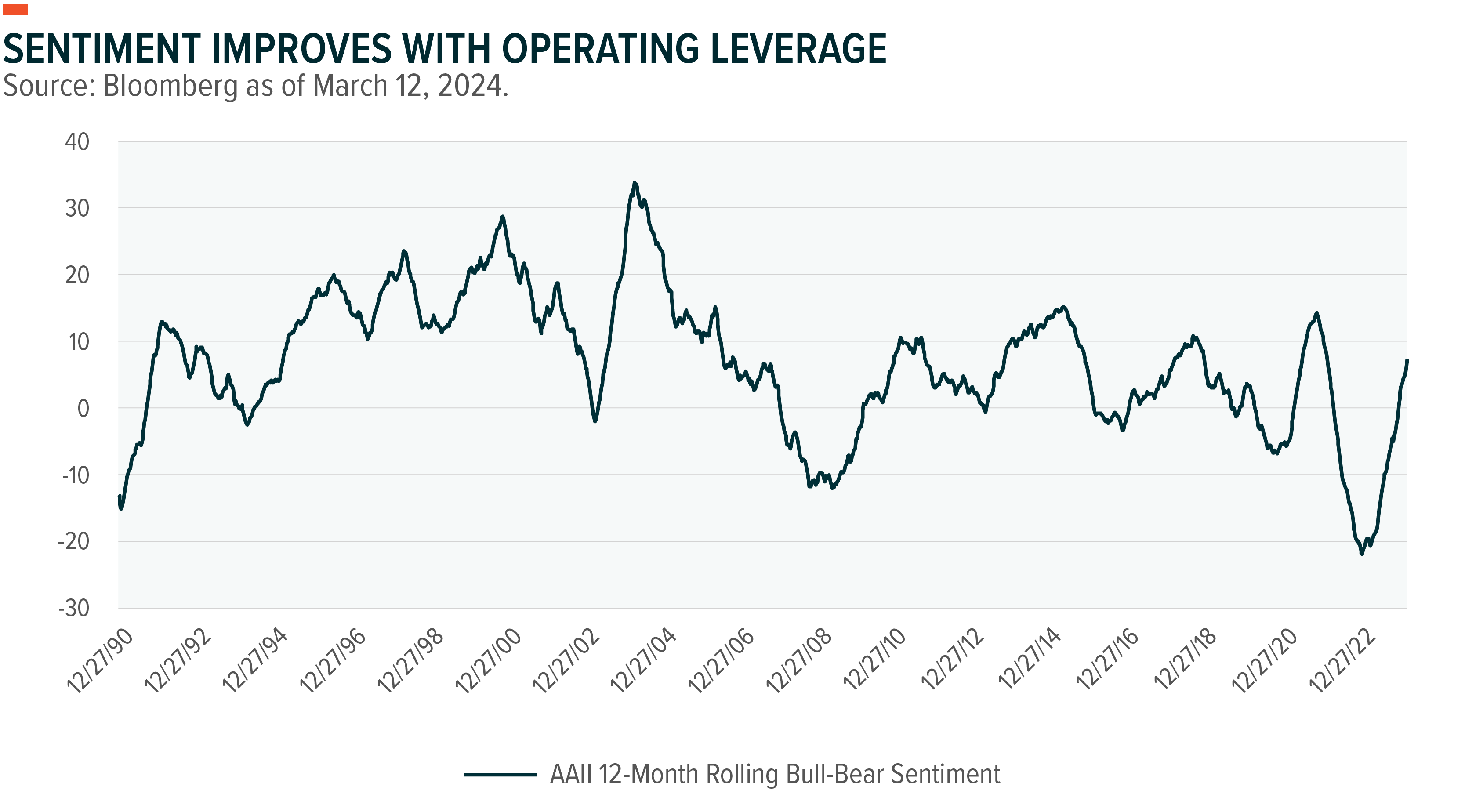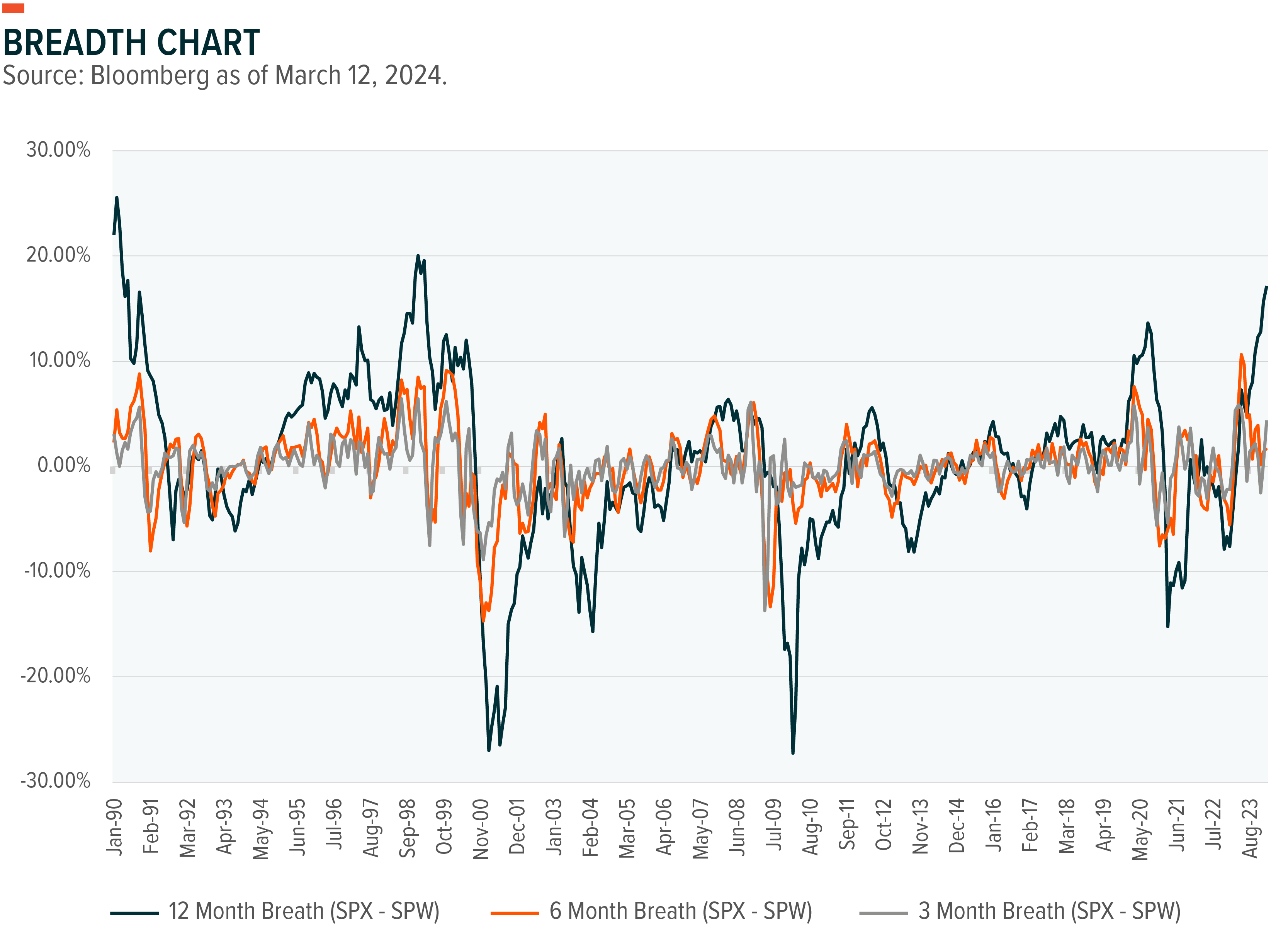The return of the operating leverage
The return of operating leverage may be one of the most important but underappreciated developments in 2024 and could be quietly driving a positive shift in market sentiment. Operating leverage broadly refers to a company’s ability to translate sales into earnings. Historically, U.S. large cap companies grow earnings at 2–3 times sales.(1) Starting in mid-2022 though, S&P 500 earnings grew slower than sales for six consecutive quarters.(2) That trend reversed in Q4 2023 when the S&P 500 grew earnings by 8% year-over-year on sales of 4%. As we kick off the Q1 2024 earnings season, S&P 500 companies are expected to grow sales by 6.5% with EPS growth of 11.2% on margins of 12.8%.(3)
That turnaround suggests companies figured out how to cope with higher costs, higher inflation, and higher rates. Better technology likely played a big role. Companies invested at near-record rates for nine successive quarters to build capacity and improve efficiency, which likely offset the slowdown in consumer spending.(4) Strong corporate performance and investment could continue to fuel the economy despite mounting risk from real interest rates around 250 basis points (bps). Positive operating leverage and its connection to sentiment could also make the cautionary tone to markets that was prominent at the start of 2024 continue to seem like a long time ago in a galaxy far, far away.
Key Takeaways
- Companies delivering positive operating leverage for the first time in nearly 2 years could provide additional fuel for equities.
- The narrative of narrow market breadth seems to be crumbling as profitability improves and more companies participate in the rally.
- Compelling opportunities may be available in themes with limited megacap tech exposure that are poised for a rebound in operating leverage like Data Centers & Digital Infrastructure, Aging Population, U.S. Infrastructure, and Video Games & Esports.
The Force Is Strong with Companies
Slowing economic growth and stubborn inflation hasn’t tarnished solid corporate performance in recent quarters. When producer price inflation peaked in Q2 2022 at 18%, companies defied expectations for plummeting profitability and delivered 13% profit margins.(5) That seemed quite resilient in the face of strong headwinds, but all was not quite well with the corporate universe though. From that point on, S&P 500 companies grew revenue faster than earnings.
The superpower of companies, or perhaps even the raison d’etre, is their ability to utilise financing, investment, and operational capabilities to earn more than $1 from $1 of sales. This ability captures the basic notion of operating leverage: translating revenue into earnings. There’s no single definition for operating leverage.(6) One approach looks at changes to operating earnings relative to sales. Another looks at the ratio of variable costs as a percentage of total (variable plus fixed) costs. Either way, when sales grow faster than earnings, corporate operations aren’t in sync with the broader economic conditions.
For six quarters, companies grew sales faster than earnings. That negative operating leverage finally turned positive as Q4 2023 financial results rolled in throughout March.(7) S&P 500 companies grew 12-month trailing earnings 12% on revenue growth of 3% (see chart), which may be an important reason for the shift in investor sentiment.

Past performance is not a reliable indicator of future performance.
The lukewarm investor sentiment of 2023 and early 2024 could be tied to poor operating leverage. Over 35 years, the AAII Bullish-Bearish Investor Sentiment measure is lower on average when companies go through periods of negative operating leverage and recovers when revenue stops “leaking out.”(8) Investors grow weary when companies struggle to navigate through new, difficult, or unexpected operating conditions. Investor sentiment improved in March 2024 as the S&P 500 returned to business as usual, helping to explain the influx of flows into risk assets totalling almost US$150 billion into equity ETFs in the U.S. year-to-date.(9)

The market’s strength flows from the breadth
Market breadth, or lack thereof, has been top of mind since the recovery off the 2022 lows. Megacap tech led stocks out of the doldrums and propelled major indexes to new heights. Many stocks did not participate in the rally and failed to hit new highs in 2023.(10) Investor reticence and narrow market breadth often go hand in hand; nervous investors look for defensive ways to increase equity exposure and often crowd into secure growth names. The risk with this strategy is that if investors sour on the small group of names, the entire index is vulnerable.
To be sure, the megacap tech names will be important in any market advance, but healthy markets are usually characterised by broad participation. And by early March, 13% of S&P 500 companies reached 52-week highs, well above the 4% in 2023 and the historical average of 5% since 1990.(11) Another means of assessing market breadth involves comparing market cap with equal weighted indexes. The equal weight index underperformed meaningfully on a 12-month rolling basis but narrowed the gap and caught up over the past 3 and 6 months (see chart).

Restoring balance to portfolios
We’ve been writing about two big headline risks in recent months. The first is underinvestment in risk assets as capital flowed to money markets and fixed income through much of 2023. The second is over-concentration in megacap tech. Now, there is nothing wrong with megacap tech, but improving market breadth suggests there could be opportunities for diversification.
Many of the themes that we track regularly defied the pull of negative operating leverage. Among them, companies tied to automation, digitalisation, and AI are less sensitive to commodity costs and have higher variable costs. Companies in the Robotics & Artificial Intelligence theme, for example, grew earnings 27% faster than sales in 2023.(12) Cloud Computing companies generated operating leverage of a whopping 137% last year. Artificial Intelligence, Internet of Things, and Cybersecurity continued growing earnings faster than sales.
Several themes mired in negative operating leverage are forecast to turn the tables, including Data Centers & Digital Infrastructure.(13) Earnings contracted as the cost of adding capacity increased, but with renewed emphasis tied to storing generative AI algos and content, the segment seems poised for a rebound. Other themes expected to return to positive operating leverage and exceed that of the S&P 500 include Aging Population, U.S. Infrastructure, and Video Games & Esports.
Preferreds, which are heavily weighted towards banks, is another market segment that can benefit from a healthier operating environment and corporate profitability normalisation. If companies grow earnings faster than sales, then the risk of default on financial obligations declines. Commercial real estate remains a concern, but even though rates remain high, the health of the commercial loan segment may be improving. With interest rates likely at their peak for the cycle and set to decline over the next 12 months, better corporate performance is supportive for bank balance sheets.
Cue Yoda.
Difficult to see, always in motion the future is. But improved investor sentiment by way of improved operating leverage suggests that it may be time to prepare for a market that shows more breadth for a sustained period.
Related funds
The Global X S&P Biotech ETF (ASX: CURE) invests in companies at the fore of healthcare innovation and genomic science, including those involved in gene editing, genomic sequencing, genetic medicine and therapy, computational genomics, and biotechnology.

The Global X Morningstar Global Technology ETF (ASX: TECH) invests in companies whose principal business is in offering Software-as-a-Service (SaaS), Platform-as-a-Service (PaaS), Infrastructure-as-a-Service (IaaS), and/or cloud and edge computing infrastructure and hardware.

The Global X Artificial Intelligence ETF (ASX: GXAI) invests in global companies involved in AI development, AI-as-a-service, provide AI compute power, or design and manufacture AI hardware.

The Global X ROBO Global Robotics & Automation ETF (ASX: ROBO) invests in robotics and artificial intelligence companies, including those involved with industrial robotics and automation, non-industrial robots, and autonomous vehicles.

4 stocks mentioned
4 funds mentioned

